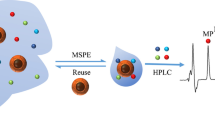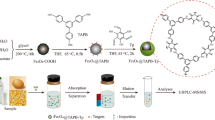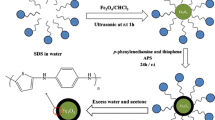Abstract
A magnetic covalent organic framework (Fe3O4@COF) with core–shell structure was fabricated at room temperature and used as an adsorbent for magnetic solid-phase extraction of polar endocrine-disrupting phenols (4-n-nonylphenol, 4-n-octylphenol, bisphenol A and bisphenol AF). The sorbent was characterized by transmission electron microscopy, FTIR, powder X-ray diffraction and other techniques. The main parameters governing the extraction efficiency were optimized. The phenols were quantified by HPLC with fluorometric detection. The method has attractive features such as low limits of detection (0.08–0.21 ng.mL−1), wide linear ranges (0.5–1000 ng.mL−1), and good repeatability (intra-day: 0.39%–4.99%; inter-day: 1.57%–5.21%). Satisfactory results were obtained when the developed method was applied to determine the four target pollutants in real world drink samples with spiked recoveries over the range of 81.3~118.0%. This indicates that the method is a powerful tool for the enrichment and determination of endocrine-disrupting phenols in drink samples.

A magnetite based covalent organic framework (Fe3O4@COFs) was synthesized with TPAB, TPA and Fe3O4. It was used for magnetic solid-phase extraction of endocrine-disrupting phenols from plastic-packaged tea drink samples coupled with liquid chromatography (LC) for determination.


Similar content being viewed by others
References
Zeng BW, Jiang P (2005) Environmental hormone. Chemical Industry Press, Beijing, pp 1–15
Du HF, Yan HF (2005) Progress on detection and analysis method of endocrine disrupting compounds. J Hyg Res 34:493–496
Jin F, Zhang Y, Wang J (2008) Review on advance of phenolic endocrine disrupting chemicals in food. Sci Technol Food Ind 29:263–270
Guenther K, Heinke V, Thiele B, Kleist E, Prast H, Raecker T (2002) Endocrine disrupting nonylphenols are ubiquitous in food. Environ Sci Technol 36:1676–1680
Del Olmo M, Zafra A, Gonzalez-casado A, Vilchez JL (1998) The use of β-cyclodextrin inclusion complexes for the analysis of bisphenol a residues in water by spectrofluorimetry. Int J Environ An Ch 69:99–110
Seifert M, Brenner-Wei β G, Haindl S, Nusser M, Obst U, Hock B (1999) A new concept for the bioeffects-related analysis of xenoestrogens: hyphenation of receptor assays with LC-MS. Fresen J Anal Chem 363:767–770
Mol HGJ, Sunarto S, Steijger OM (2000) Determination of endocrine disruptors in water after derivatization with N-methyl-N-(tert-butyldimethyltrifluoroacetamide) using gas chromatography with mass spectrometric detection. J Chromatogr A 879:97–112
Konig H, Ryschka R, Strobel W (1985) Trennung, identifizierung und bestimmung nichtionischer tenside mittels hochleistungs-fliissigkeits-chromatographie. Z Anal Chem 321:263–267
Tran NH, Hu JY, Ong SL (2013) Simultaneous determination of PPCPs, EDCs, and artificial sweeteners in environmental water samples using a single-step SPE coupled with HPLC–MS/MS and isotope dilution. Talanta 113:82–92
Gong SX, Wang XL, Liu W, Wang ML, Wang X, Wang ZW, Zhao RS (2017) Aminosilanized magnetic carbon microspheres for the magnetic solid-phase extraction of bisphenol A, bisphenol AF, and tetrabromobisphenol A from environmental water samples. J Sep Sci 40:1755–1764
Miyakoda H, Tabata M, Onodera S, Takeda K (1999) Passage of bisphenol A into the fetus of the pregnant rat. J Health Sci 45:318–323
Gonzalez-Casado A, Navas N, Del Olmo M, Vilchez JL (1998) Determination of bisphenol A in water by micro liquid-liquid extraction followed by silylation and gas chromatography-mass spectrometry analysis. J Chromatogr Sci 36:565–569
Marcomini A, Giger W (1987) Simultaneous determination of linear alkylbenzenesulfonates, alkylphenol polyethoxylates, and nonylphenol by high performance liquid chromatography. Anal Chem 59:1709–1715
Chalaux N, Bayona JM, Albaiges J (1999) Determination of nonylphenols as pentafluorobenzyl derivatives by capillary gas chromatography with electroncapture and mass spectrometric detection in environmental matrices. J Chromatogr A 686:275–281
Salafranca J, Batlle R, Nerin C (1999) Use of solid-phase microextraction for the analysis of bisphenol A and bisphenol A diglycidyl ether in food simulants. J Chromatogr A 864:137–144
Zhao Q, Lu Q, Feng YQ (2013) Dispersive microextraction based on magnetic polypyrrole nanowires for the fast determination of pesticide residues in beverage and environmental water samples. Anal Bioanal Chem 405:4765–4776
Xiao DL, Lu T, Zeng R, Bi YP (2016) Preparation and highlighted applications of magnetic microparticles and nanoparticles: a review on recent advances. Microchim Acta 183:2655–2675
Zou Y, Chen YZ, Yan ZH, Chen CY, Wang JP, Yao SZ (2013) Magnetic solid-phase extraction based on tetrabenzyl modified Fe3O4 nanoparticles for the analysis of trace polycyclic aromatic hydrocarbons in environmental water samples. Analyst 138:5904–5912
Huo SH, Yan XP (2012) Facile magnetization of metal–organic framework MIL-101 for magnetic solid-phase extraction of polycyclic aromatic hydrocarbons in environmental water samples. Analyst 137:3445–3451
Liu L, Feng T, Wang C, Wu QH, Wang Z (2014) Magnetic three-dimensional graphene nanoparticles for the preconcentration of endocrine-disrupting phenols. Microchim Acta 181:1249–1255
Xu Z, Ding L, Long YJ, Xu LG, Wang LB, Xu CL (2011) Preparation and evaluation of superparamagnetic surface molecularly imprinted polymer nanoparticles for selective extraction of bisphenol a in packed food. Anal Methods 3:1737–1744
Wu XQ, Wang XY, Lu WH, Wang XR, Li JH, You HY, Xiong H, Chen LX (2016) Water-compatible temperature and magnetic dual-responsive molecularly imprinted polymers for recognition and extraction of bisphenol A. J Chromatogr A 1435:30–38
Chen SQ, Chen JP, Zhu SX (2016) Solid phase extraction of bisphenol a using magnetic core–shell (Fe3O4@SiO2) nanoparticles coated with an ionic liquid, and its quantitation by HPLC. Microchim Acta 183:1315–1321
Li F, Cai CC, Cheng J, Zhou HB, Ding KR, Zhang LZ (2015) Extraction of endocrine-disrupting phenols with iron-ferric oxide core–shell nanowires on graphene oxide nanosheets, followed by their determination by HPLC. Microchim Acta 182:2503–2511
Coˇte AP, Benin AI, Ockwig NW, Keeffe MO, Matzger AJ, Yaghi OM (2005) Porous, crystalline, covalent organic frameworks. Science 310:1166–1170
Wang X, Han X, Zhang J, Wu XW, Liu Y, Cui Y (2016) Homochiral 2D porous covalent organic frameworks for heterogeneous asymmetric catalysis. J Am Chem Soc 138:12332–12335
Huang N, Chen X, Krishna R, Jiang DL (2015) Two-dimensional covalent organic frameworks for carbon dioxide capture through Channel-Wall functionalization. Angew Chem Int Ed 54:2986–2990
Stange P, Fumino K, Kudwig R (2013) Ion speciation of protic ionic liquids in water: transition from contact to solvent-separated ion pairs. Angew Chem Int Ed 52:2990–2994
Yang CX, Liu C, Cao YM, Yan XP (2015) Facile room-temperature solution-phase synthesis of a spherical covalent organic framework for high-resolution chromatographic separation. Chem Commun 51:12254–12257
Li Z, Zhang YW, Xia H, Mu Y, Liu X (2016) A robust and luminescent covalent organic framework as a highly sensitive and selective sensor for the detection of Cu(2+) ions. Chem Commun 52:6613–6616
Lin G, Gao CH, Zheng Q, Lei ZX, Geng HJ, Lin Z, Yanga HH, Cai ZW (2017) Room-temperature synthesis of core–shell structured magnetic covalent organic framework for efficient enrichment of peptides and simultaneous exclusion of proteins. Chem Commun 53:3649–3652
Li N, Wu D, Hu N, Fan GS, Li XT, Sun J, Chen XF, Suo YR, Li GL, Wu YN (2018) Effective enrichment and detection of trace polycyclic aromatic hydrocarbons in food samples based on magnetic covalent organic framework hybrid microspheres. J Agric Food Chem 66:3572–3580
Wang XY, Deng CH (2015) Preparation of magnetic graphene @polydopamine@Zr-MOF material for the extraction and analysis of bisphenols in water samples. Talanta 144:1329–1335
Yang JJ, Li Y, Wang JC, Sun XL, Cao R, Sun H, Huang CN, Chen JP (2015) Molecularly imprinted polymer microspheres prepared by Pickering emulsion polymerization for selective solid-phase extraction of eight bisphenols from human urine samples. Anal Chim Acta 872:35–45
Herrero-Hernández E, Carabias-Martínez R, Rodríguez-Gonzalo E (2009) Use of a bisphenol-A imprinted polymer as a selective sorbent for the determination of phenols and phenoxyacids in honey by liquid chromatography with diode array and tandem mass spectrometric detection. Anal Chim Acta 650:195–201
Maragou NC, Lampi EN, Thomaidis NS, Koupparis MA (2006) Determination of bisphenol A in milk by solid phase extraction and liquid chromatography–mass spectrometry. J Chromatogr A 1129:165–173
Acknowledgements
This work was supported by the National Natural Science Foundation of China (21777089), the Natural Science Foundation of Shandong Province (ZR2018MB040), the Key Research and Development Program of Shandong Province (2017GSF17107 and 2018GSF117036), Shandong Provincial Key Laboratory of Test Technology for Material Chemical Safety (2018SDCLHX001), and the Shandong Province Taishan Scholar Program (ts201712063).
Author information
Authors and Affiliations
Corresponding author
Ethics declarations
The author(s) declare that they have no competing interests.
Additional information
Publisher’s Note
Springer Nature remains neutral with regard to jurisdictional claims in published maps and institutional affiliations.
Electronic supplementary material
ESM 1
(DOC 1310 kb)
Rights and permissions
About this article
Cite this article
Deng, ZH., Wang, X., Wang, XL. et al. A core-shell structured magnetic covalent organic framework (type Fe3O4@COF) as a sorbent for solid-phase extraction of endocrine-disrupting phenols prior to their quantitation by HPLC. Microchim Acta 186, 108 (2019). https://doi.org/10.1007/s00604-018-3198-3
Received:
Accepted:
Published:
DOI: https://doi.org/10.1007/s00604-018-3198-3




